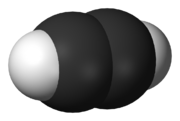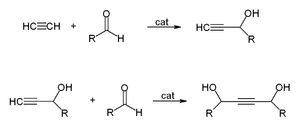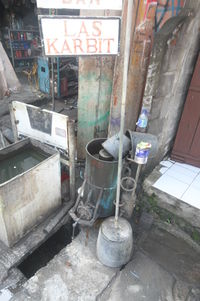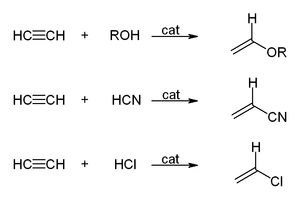Acetylene
| Acetylene | |
|---|---|
 |
|
 |
|
|
Acetylene[1]
|
|
|
Ethyne
|
|
| Identifiers | |
| CAS number | 74-86-2 |
| ChemSpider | 6086 |
| UN number | 1001 (dissolved) 3138 (in mixture with ethylene and propylene) |
|
SMILES
C#C
|
|
|
InChI
InChI=1/C2H2/c1-2/h1-2H
Key: HSFWRNGVRCDJHI-UHFFFAOYAY |
|
| Properties | |
| Molecular formula | C2H2 |
| Molar mass | 26.04 g mol−1 |
| Density | 1.097 kg/m3 |
| Melting point |
−80.8 °C (189 K, subl) |
| Boiling point |
−84 °C |
| Acidity (pKa) | 25 |
| Structure | |
| Molecular shape | Linear |
| Thermochemistry | |
| Std enthalpy of formation ΔfH |
+226.88 kJ/mol |
| Hazards | |
| NFPA 704 |
 4
1
3
|
| Except where noted otherwise, data are given for materials in their standard state (at 25 °C, 100 kPa) |
|
| Infobox references | |
Acetylene (systematic name: ethyne) is the chemical compound with the formula HC2H. It is a hydrocarbon and the simplest alkyne. This colourless gas is widely used as a fuel and a chemical building block. It is unstable in pure form and thus is usually handled as a solution.
As an alkyne, acetylene is unsaturated because its two carbon atoms are bonded together in a triple bond. The carbon-carbon triple bond places all four atoms in the same straight line, with CCH bond angles of 180°. Since acetylene is a linear symmetrical molecule, it possesses the D∞h point group[2].
Contents |
Discovery
Acetylene was discovered in 1836 by Edmund Davy who identified it as a "new carburet of hydrogen". It was rediscovered in 1860 by French chemist Marcellin Berthelot, who coined the name "acetylene". Berthelot was able to prepare this gas by passing vapours of organic compounds (methanol, ethanol, etc.) through a red-hot tube and collecting the effluent. He also found acetylene was formed by sparking electricity through mixed cyanogen and hydrogen gases. Berthelot later obtained acetylene directly by passing hydrogen between the poles of a carbon arc.[3]
Preparation
Today acetylene is mainly manufactured by the partial combustion of methane or appears as a side product in the ethylene stream from cracking of hydrocarbons. Approximately 400,000 tonnes are produced this way annually.[4] Its presence in ethylene is usually undesirable because of its explosive character and its ability to poison Ziegler-Natta catalysts. It is selectively hydrogenated into ethylene, usually using Pd-Ag catalysts.[5]
Until the 1950s, when oil supplanted coal as the chief source of carbon, acetylene (and the aromatic fraction from coal tar) was the main source of organic chemicals in the chemical industry. It was prepared by the hydrolysis of calcium carbide, a reaction discovered by Friedrich Wöhler in 1862 and still familiar to students:
- CaC2 + 2H2O → Ca(OH)2 + C2H2
Calcium carbide production requires extremely high temperatures, ~2000 °C, necessitating the use of an electric arc furnace. In the US, this process was an important part of the late-1800s revolution in chemistry enabled by the massive hydroelectric power project at Niagara Falls.
Bonding
In terms of valence bond theory, in each carbon atom the 2s orbital hybridizes with one 2p orbital thus forming an sp hybrid. The other two 2p orbitals remain unhybridized. The two ends of the two sp hybrid orbitals overlap to form a strong σ valence bond between the carbons, while on each of the other two ends hydrogen atoms attach also by σ bonds. The two unchanged 2p orbitals form a pair of weaker π valence bonds.[6]
Reactions
One new application is the conversion of acetylene to ethylene for use in making a variety of polyethylene plastics. An important reaction of acetylene is its combustion, the basis of the acetylene welding technologies. Otherwise, its major applications involve its conversion to acrylic acid derivatives. Acetylides with many metal ions by reactions of with solutions of their salts. Several, e.g., silver acetylide and copper acetylide, are powerful and very dangerous explosives. Copper acetylide is also formed by reacting acetylene with metallic copper or its alloys; these materials are therefore unsuitable for installations for handling acetylene.
Reppe chemistry
Walter Reppe discovered that in the presence of metal catalysts, acetylene can react to give a wide range of industrially significant chemicals.
- With alcohols, hydrogen cyanide, hydrogen chloride, or carboxylic acids to give vinyl compounds:
- With aldehydes to give ethynyl diols.

- 1,4-Butynediol is produced industrially in this way from formaldehyde and acetylene.
- With carbon monoxide to give acrylic acid, or acrylic esters, which can be used to produce acrylic glass.
- Cyclicization to give benzene and cyclooctatetraene:
Welding
Approximately 20 percent of acetylene is consumed for oxyacetylene gas welding and cutting due to the high temperature of the flame; combustion of acetylene with oxygen produces a flame of over 3600 K (3300 °C, 6000 °F), releasing 11.8 kJ/g. Oxyacetylene is the hottest burning common fuel gas.[7] Acetylene is the third hottest natural chemical flame after cyanogen at 4798 K (4525 °C, 8180 °F) and dicyanoacetylene's 5260 K (4990 °C, 9010 °F). Oxy-acetylene welding was a very popular welding process in previous decades; however, the development and advantages of arc-based welding processes have made oxy-fuel welding nearly extinct for many applications. Acetylene usage for welding has dropped significantly. On the other hand, oxy-acetylene welding equipment is quite versatile – not only because the torch is preferred for some sorts of iron or steel welding (as in certain artistic applications), but also because it lends itself easily to brazing, braze-welding, metal heating (for annealing or tempering, bending or forming), the loosening of corroded nuts and bolts, and other applications. Oxyacetylene welding may also be used in areas where electricity is not readily accessible. As well, oxy-fuel cutting is still very popular and oxy-acetylene cutting is utilized in nearly every metal fabrication shop. For use in welding and cutting, the working pressures must be controlled by a regulator, since above 15 psi[8] acetylene will decompose explosively.

Niche and historically interesting applications
In 1881, the Russian chemist Mikhail Kucherov[9] described the hydration of acetylene to acetaldehyde using catalysts such as mercury(II) bromide. Before the advent of the Wacker process, this reaction was conducted on an industrial scale.[10]
The polymerization of acetylene with Ziegler-Natta catalysts produces polyacetylene films. Polyacetylene, a chain of CH centres with alternating single and double bonds, was the one of first discovered organic semiconductors. Its reaction with iodine produces a highly electrically conducting material. Although such materials are not useful, these discoveries led to the developments of organic semiconductors, as recognized by the Nobel Prize in Chemistry in 2000 to Alan J. Heeger, Alan G MacDiarmid, and Hideki Shirakawa.
In the early 20th Century acetylene was widely used for illumination, including street lighting in some towns.[11] Most early automobiles used carbide lamps before the adoption of electric headlights.
Acetylene is sometimes used for carburization (that is, hardening) of steel when the object is too large to fit into a furnace.[7]
Acetylene is used to volatilize carbon in radiocarbon dating. The carbonaceous material in an archeological sample is reacted with lithium metal in a small specialized research furnace to form lithium carbide (also known as lithium acetylide). The carbide can then be reacted with water, as usual, to form acetylene gas to be fed into mass spectrometer to sort out the isotopic ratio of carbon 14 to carbon 12.
Natural occurrence
Acetylene is a moderately common chemical in the universe, often associated with the atmospheres of gas giants.[12] One curious discovery of acetylene is on Enceladus, a moon of Saturn. Natural acetylene is believed to form from either catalytic decomposition of long chain hydrocarbons at temperatures of 1,770 K and above. Since such temperatures are highly unlikely on such a small distant body, this discovery is potentially suggestive of catalytic reactions within the moon, making it a promising site to search for prebiotic chemistry.[13][14]
Safety and handling
Acetylene is not especially toxic but when generated from calcium carbide it can contain toxic impurities such as traces of phosphine and arsine. It is also highly flammable (hence its use in welding). Its singular hazard is associated with its intrinsic instability, especially when it is pressurized. Samples of concentrated or pure acetylene can easily react in an addition-type reaction to form a number of products, typically benzene and/or vinylacetylene. This reaction is exothermic. Consequently, acetylene can explode with extreme violence if the pressure of the gas exceeds about 200 kPa (29 psi) as a gas[15] or when in liquid or solid form. It is therefore shipped and stored dissolved in acetone or dimethylformamide (DMF), contained in a metal cylinder with a porous filling (Agamassan), which renders it safe to transport and use, given proper handling.
References
- ↑ Acyclic Hydrocarbons. Rule A-3. Unsaturated Compounds and Univalent Radicals, IUPAC Nomenclature of Organic Chemistry
- ↑ Housecroft, C. E.; Sharpe, A. G. (2008). Inorganic Chemistry (3rd ed.). Prentice Hall. pp. 94–95. ISBN 978-0131755536.
- ↑ Acetylene
- ↑ Peter Pässler, Werner Hefner, Klaus Buckl, Helmut Meinass, Andreas Meiswinkel, Hans-Jürgen Wernicke, Günter Ebersberg, Richard Müller, Jürgen Bässler, Hartmut Behringer, Dieter Mayer “Acetylene” in Ullmann's Encyclopedia of Industrial Chemistry, 2008, Wiley-VCH, Weinheim. doi:10.1002/14356007.a01_097.pub3. Article Online Posting Date: 15 October 2008
- ↑ Acetylene: How Products are Made
- ↑ Organic Chemistry 7th ed. by J. McMurry, Thomson 2008
- ↑ 7.0 7.1 Acetylene, BOC
- ↑ http://www.c-f-c.com/specgas_products/acetylene.htm
- ↑ Kutscheroff, M. "Ueber eine neue Methode direkter Addition von Wasser (Hydratation) an die Kohlenwasserstoffe der Acetylenreihe" Berichte der deutschen chemischen Gesellschaft 1881, Volume 14, 1540–1542. doi:10.1002/cber.188101401320
- ↑ Dmitry A. Ponomarev and Sergey M. Shevchenko (2007). "Hydration of Acetylene: A 125th Anniversary". J. Chem. Ed. 84 (10): 1725. http://jchemed.chem.wisc.edu/HS/Journal/Issues/2007/OctACS/ACSSub/p1725.pdf.
- ↑ The 100 most important chemical compounds: a reference guide
- ↑ W. M. Keck Observatory (20 December 2005). "Precursor to Proteins and DNA found in Stellar Disk". Press release. http://www.keckobservatory.org/article.php?id=39.
- ↑ Emily Lakdawalla (17 March 2006). "LPSC: Wednesday afternoon: Cassini at Enceladus". The Planetary Society. http://www.planetary.org/blog/article/00000498/.
- ↑ John Spencer and David Grinspoon (25 January 2007). "Planetary science: Inside Enceladus". Nature 445: 376–377. doi:10.1038/445376b.
- ↑ Korzun, Mikołaj (1986). 1000 słów o materiałach wybuchowych i wybuchu. Warszawa: Wydawnictwo Ministerstwa Obrony Narodowej. ISBN 83-11-07044-X. OCLC 69535236.
External links
- Acetylene at Chemistry Comes Alive!
- Acetylene, the Principles of Its Generation and Use at Project Gutenberg
- Movie explaining acetylene formation from calcium carbide and the explosive limits forming fire hazards
|
|||||




